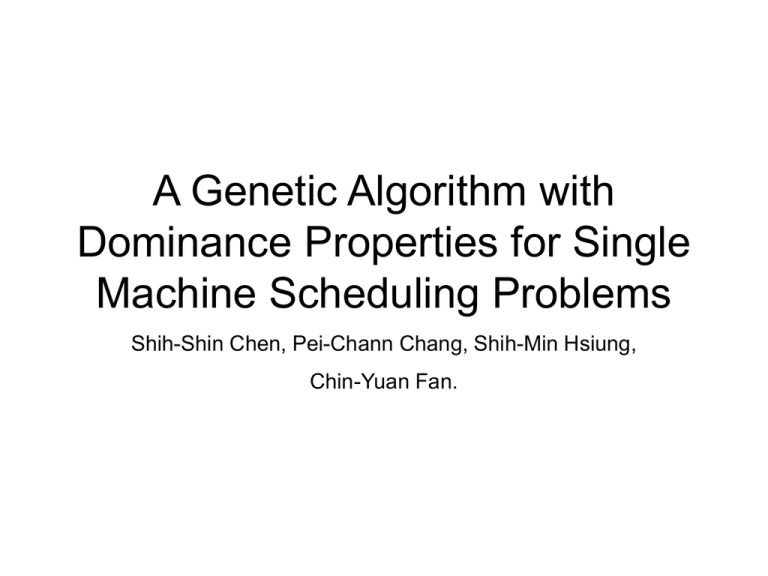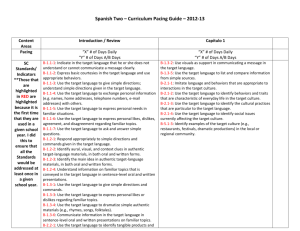A Genetic Algorithm with Dominance Properties for Single Machine
advertisement

A Genetic Algorithm with Dominance Properties for Single Machine Scheduling Problems Shih-Shin Chen, Pei-Chann Chang, Shih-Min Hsiung, Chin-Yuan Fan. Introduction • Single-machine scheduling problems are one of the well-known problems that have been studied by many researchers. The results not only provide the insights into the single machine problem but also for more complicated environment. The objective of this study is as follows: n n min Z E j T j d C j j 1 j 1 • Allahverdi et al. [2] reviewed the scheduling literature that involved setup times. In their review, very few papers addressed the E/T problem with setup times, and no papers ever tackled the problem as addressed in this research with the development of dominance properties. As a result, this paper fills the gape of proving some dominance properties for E/T problem with setup times in a single machine scheduling problem. Problem Statements • We consider the sequence-dependent scheduling problem with a common due date. An optimal sequence in which the b-th job is completed at the due-date. The value of b is given by: if n is even, n/2 b (n 1)/2 if n is odd. • The optimal common due-date (k*) is the sum of processing times of jobs in the first b position of the sequence; i.e. k* Cb • Jobs can be classified into two different groups that are either early or tardy. The early group is from position 1 to position b and the late group is from position b+1 to position n respectively. The following notations are employed in the latter section. • [j]: job in position j • A: the set of tardy jobs • B: the set of early jobs • :Adjusted processing time for the job in position • [ j +1] preceded by the job in position [j] • b: the median position n • Minimize • where • TT: Total tardiness for a job sequence • TE: Total earliness for a job sequence Z ( E T ) TT TE i i 1 n-1 b j b j1 i TT (n-j)AP[j][j1] TE (j-1)AP[j-1][j] AP[b-3][b-2] AP[b-2][b-1] AP[b-1][b] AP[b][b+1] AP[b+1][b+2] AP[b+2][b+3] AP[0][1] [1] ..... [b-2] [b-1] [b] [b+1] d [b+2] [b+3] AP[n-1][n] ..... [n] Derivations of Dominance Properties x ..... y ..... i-1 i i-1 j G1 x j i j+1 ..... j+1 ..... G2 G3 ..... i-1 i i+1 ..... j-1 j j+1 y ..... i-1 j i+1 ..... j-1 i j+1 G1 G2 Adjacent interchange G3 ..... ..... Nonadjacent interchange • • • • • • • G1: the objective value of for job(s) before job i G2: the objective value of for jobs between job i and job j G3: the objective value of for job(s) after job j G2’: the objective value of for jobs between job j and job i G3’: the objective value of for job(s) after job i • • • • • 1. Job i is early and job j is early 2. Job i is early and job j is on-time 3. Job i is on-time and job j is tardy 4. Job i is tardy and job j is tardy 5. Job i is early and job j is tardy A. Dominance Properties of Adjacent Interchange B. Dominance Properties of Nonadjacent Interchange Implementation of Dominance Properties with Genetic Algorithm • The purpose is to take the advantage of dominance properties because it works efficiently while it also encounters trapping into local optimal. Thus, Genetic algorithm is applied here to obtain better solution quality. DP GA Experimental Results • The testing instances: Rabadi et al.[16] – Job size of each instance includes 10, 15, 20, and 25. • The property of the processing time range contains low, median, and high. • The proposed algorithm GADP is compared with Simple Genetic Algorithm. • The stopping criterion is to have examined 100,000 solutions. The average relative error ratio for the three algorithms (%) Type Size First Phase SGA GADP Low 10 4.32 2.07 0.3117 15 24.345 6.177 3.217 20 43.821 10.636 7.055 25 59.314 13.67 9.74 10 4.941 2.983 1.007 15 30.078 10.367 5.075 20 50.933 16.083 10.281 25 70.427 22.553 15.5 10 7.46 3.408 0.662 15 33.975 13.73 7.067 20 58.63 23.47 14.635 25 78.99 27.83 20.454 Median High Duncan Grouping A B C Mean N Method 1961.921 5400 First Phase (DP) 1513.179 5400 SGA 1439.981 5400 GADP Obtain a good initial solutions for GA. DP Although it’s better than DP, it is worse than GADP significantly. SGA Outperform other algorithms. GADP 8800 SGA GADP 7800 6800 5800 4800 3800 2800 0 200 400 600 800 1000 Discussion and Conclusions • These dominance properties determine relationship between a pair of jobs mathematically. In addition, these dominance properties apply the general pairwise interchange and this method is further integrated with genetic algorithm, which is called GADP. • From the experimental results, the first phase is able to construct better initial solutions so that while GA applies these initial solutions, it enables genetic algorithm to quickly converge to optimal solution or near optimal solution.








